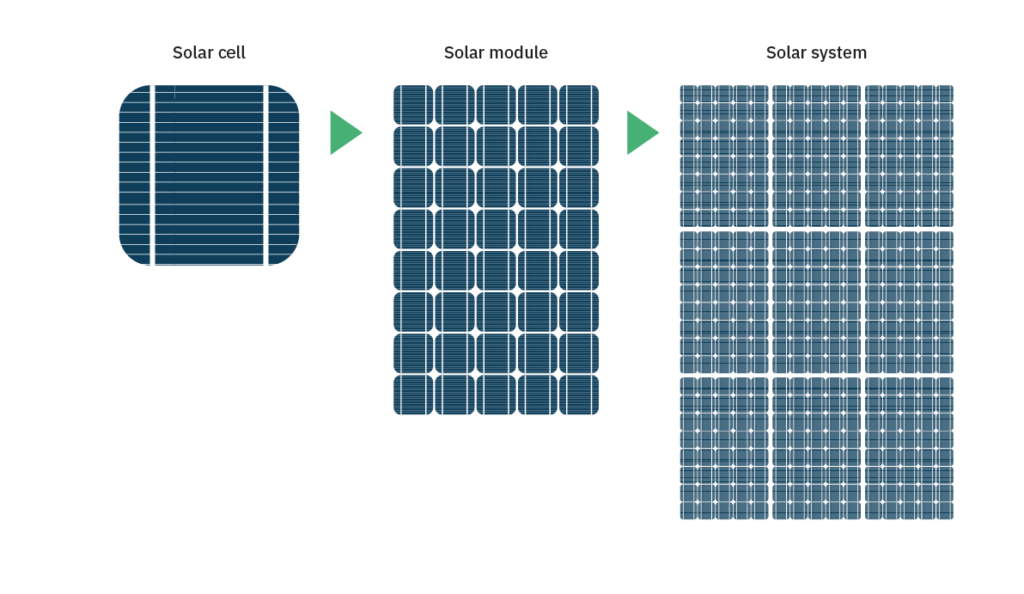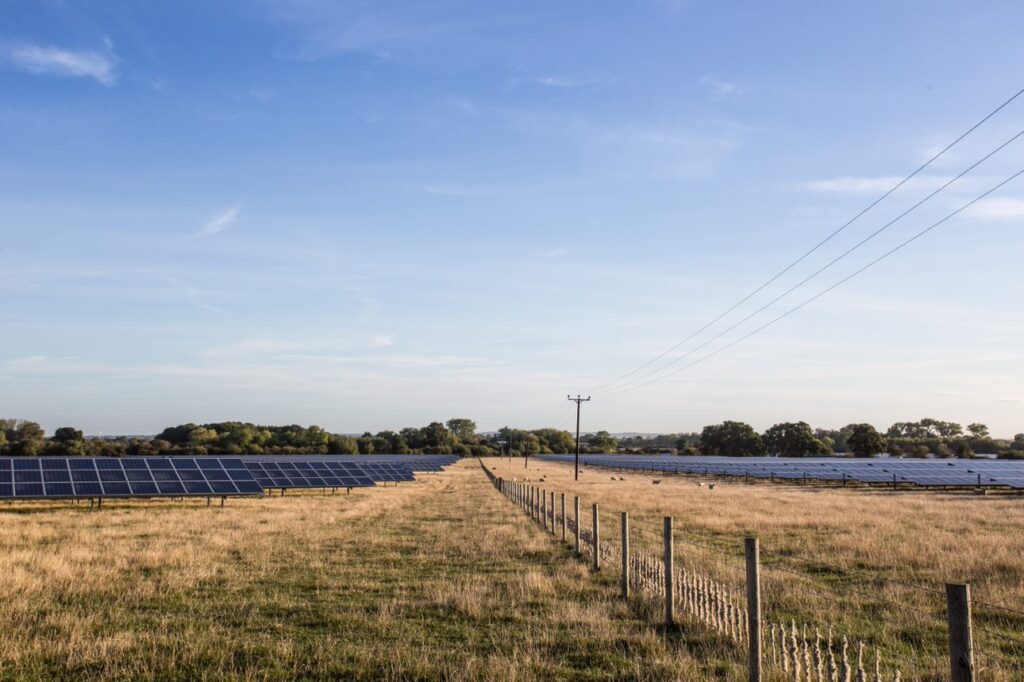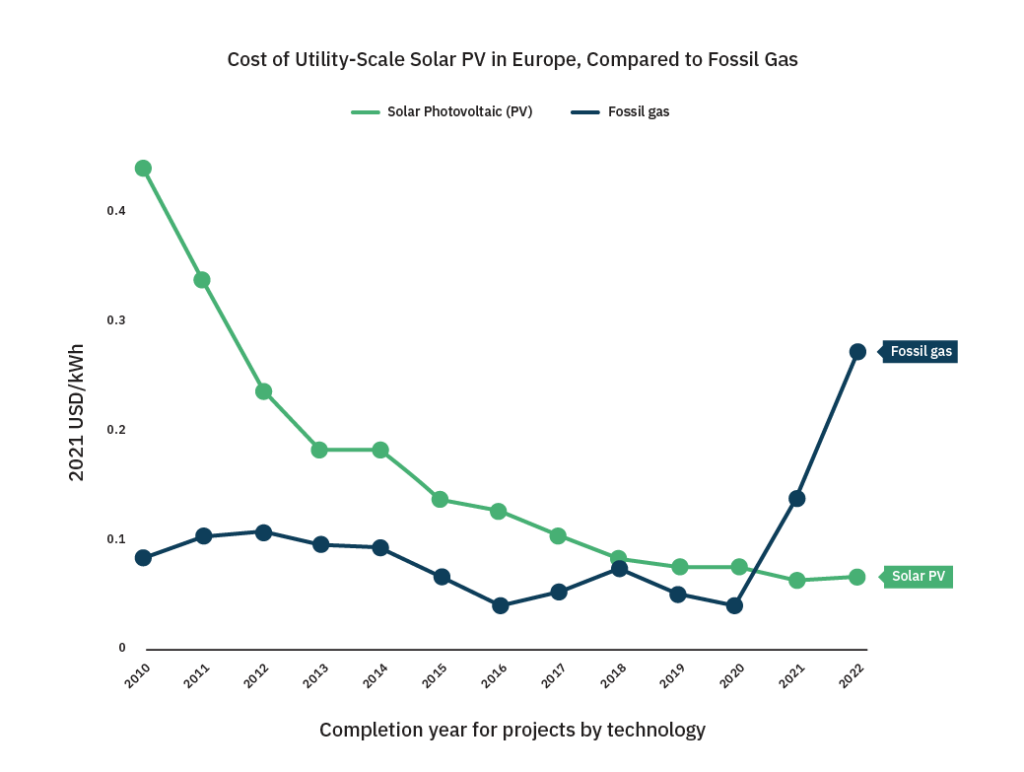What is photovoltaic (PV) energy?
Photovoltaic energy is electricity produced by converting sunlight into electrical energy through photovoltaic (PV) panels – this energy can then either be used immediately as electricity or stored in batteries.
How do photovoltaic (PV) solar panels work?
When the sun shines onto a solar panel, energy from the sunlight is absorbed by the photovoltaic cells in the panel. Solar cells contain a material that conducts electricity only when energy is provided—in this case by sunlight. This energy creates electrical charges that move in response to an internal electrical field in the cell, causing electricity to flow1.
Solar cells are connected together to make a ‘module’ and these modules are then connected to make a solar system, or installation2.

What are the challenges of solar?
One of the challenges facing the production of solar energy is that it is weather and daylight hours dependent – this is a more significant challenge at higher latitude locations where daylight house in winter are very short resulting in a shorter period of production. However solar panels are actually more efficient in colder temperatures3 and snow/frost reflect light and improve PV performance4, which goes some way to addressing the shortfall caused by fewer daylight hours. Irradiation forecasts are now extremally accurate, which enables accurate predication of shortfalls in solar energy production, which can then be supplemented by other sources to ensure a consistent supply into the grid.
Traditional solar farms also require large areas of land – which has often lead to the perception that other potential uses for this land are minimal, and many local communities are initially resistant to the idea. However development of solar farms is focused on poor quality land that is unsuitable for mainstream agriculture, and many investors and managers of solar plants, including Bluefield, implement land management practices to improve soil quality and biodiversity over the long term.

If you are interested in how solar farm land can be utilised for more than just energy production, read Bluefield Operations case study on the integration of livestock to East Farm.
What is the opportunity?
One of the key challenges of traditional, fossil fuel, sources of energy is that there is a finite supply of the raw materials. They are also hugely carbon emitting, which contributes to global warming and associated climate change.
Solar energy has the advantage of relying predominantly on an inexhaustible, constantly renewing (hence the name, renewable energy) and highly predictable energy source – the sun. It is also a clean source of energy as no carbon is released to produce this type of energy.
Photovoltaic (PV) technology is now well established and very reliable5. Unlike some other sources of renewable energy, solar panels do not include moving parts that require high levels of maintenance, keeping running costs down.
Solar energy is also now one of the cheapest methods of producing electrical energy in most of the world. The cost of utility scale solar in Europe has been significantly less than fossil gas since 20206.

As an increasingly accessible technology, solar will continue to drive the energy transition away from traditional energy sources. In order to achieve the Paris Agreement goals to reduce global warming, a significant investment is required into technologies that will both extract greenhouse gasses from the atmosphere and limit ongoing emissionsvii – where solar will play a key role in the latter.
Want to learn more about solar and other forms of renewable energy? These articles might be of interest:
https://bluefieldllp.com/what-are-renewables/
https://bluefieldllp.com/the-evolution-of-renewable-energy/
Get in touch to learn more about how Bluefield companies advise on investing in, managing, operating and developing solar renewable energy.
Bluefield, powering a sustainable future.
[1] How does solar work? (nd). Office of Energy Efficiency and Renewable Energy. Available at: https://www.energy.gov/eere/solar/how-does-solar-work
[2] PV Cells 101: A Primer on the Solar Photovoltaic Cell (2019). Office of Energy Efficiency and Renewable Energy . Available at: https://www.energy.gov/eere/solar/articles/pv-cells-101-primer-solar-photovoltaic-cell
[3] Do solar panels work in winter and on cloudy days? (2012)E.ON. Available at: https://www.eonenergy.com/our-blog/do-solar-panels-work-in-winter.html
[4] Do solar panels work in the winter? (nd) Energy Gain UK ltd. Available at: https://energygain.co.uk/do-solar-panels-work-in-the-winter
[5] How reliable is solar energy? (2023) Ecoflow. Available at: https://blog.ecoflow.com/us/how-reliable-is-solar-energy
[6] Renewable Power Remains Cost Competitive amid Fossil Fuel Crisis (2022) IRENA.Available at: https://www.irena.org/news/pressreleases/2022/Jul/Renewable-Power-Remains-Cost-Competitive-amid-Fossil-Fuel-Crisis [1] What investments are needed in the global energy system in order to satisfy the NDCs and 2 and 1.5 °C goals? (2020) International Institute for Applied Systems Analysis. Available at: https://unfccc.int/sites/default/files/resource/367_Investments_Policy_Brief_2018-10-26.pdf


